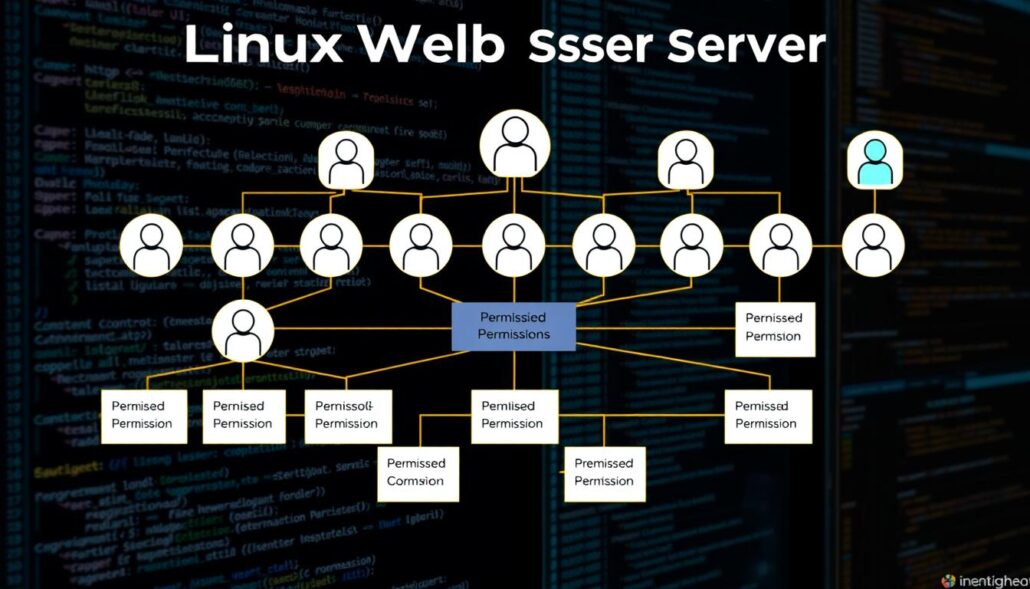I’m excited to share a detailed guide on setting up a Linux web server from the start. This guide is for both beginners and those with some experience. It will show you how to install, set up, and keep a web server running on Ubuntu.
In today’s world, having a dependable and safe web server is key for hosting websites and online services. Ubuntu is a great choice for building web servers because it’s easy to use. This guide will cover setting up a Linux web server on Ubuntu. We’ll talk about choosing the right hardware, installing software, setting up firewalls, and keeping your server running smoothly.
Key Takeaways
- Learn how to set up a Linux web server from scratch using Ubuntu
- Understand the key features and benefits of Ubuntu web servers
- Discover the necessary hardware requirements for hosting web applications
- Explore popular web server software options and select the right one for your needs
- Gain insights into configuring and securing your Linux web server
Introduction to Web Servers on Ubuntu
What Is a Web Server on Ubuntu?
A web server is software that sends web pages and images over the internet. It uses the Hypertext Transfer Protocol (HTTP) to talk to clients like web browsers. Ubuntu, a popular Linux, is great for hosting web servers because it’s stable, secure, and easy to use.
Key Features of Ubuntu Web Servers
Ubuntu web servers can handle simple websites or complex web apps. They support software like Apache, Nginx, and Lighttpd. Each has special features, like Apache’s modularity and Nginx’s speed with static content.
Ubuntu’s APT system makes installing and updating web servers easy. It offers stable versions in its repositories. The setup is simple thanks to well-organized configuration files. Plus, Ubuntu has security features like AppArmor and regular updates for a safe environment.
Ubuntu web servers work well with important web technologies and databases. This makes them perfect for many web applications. The Ubuntu community offers lots of help, including tutorials and forums, for users at any level.
“Ubuntu’s web server capabilities make it a popular choice for hosting a wide range of websites and web applications, from small personal blogs to large-scale enterprise solutions.”
Choosing the Right Hardware
Setting up a Linux web server from scratch means picking the right hardware. You can turn any computer into a web server, but think about what it needs. For a busy website, you’ll need a strong processor, lots of memory, and plenty of storage.
If your site won’t get much traffic, a simpler machine will do. Think about how big your site might get and choose your hardware wisely.
Also, the hardware’s reliability is key. A web server runs all the time, so parts must last long. Having a backup power source is smart, too, in case of power cuts.
| Hardware Component | Recommended Specification |
|---|---|
| Processor (CPU) | Multi-core processor for handling multiple tasks |
| RAM | At least 4GB, but 8GB or more is better for intensive tasks |
| Storage | HDD or SSD with at least 180-200GB of space |
| Network Interface | Wired Ethernet connection for reliability over Wi-Fi |
| Cooling | Ensure adequate cooling, especially in dusty environments |
Choosing the right hardware for your Linux web server is crucial. Think about your website’s needs and where it will be. Good hardware means your server can handle the job well and keep your site running smoothly.
“Investing in reliable and high-quality hardware is essential for ensuring the long-term stability and performance of your Linux web server.”
Selecting an Operating System
The operating system is key to your web server. It manages resources and services your website needs. For web servers, you mainly choose between Linux and Windows.
Linux vs Windows for Web Servers
Linux is popular for web servers because it’s stable, secure, and affordable. Operating systems like Ubuntu and CentOS are reliable and flexible. They support various web server software, like Apache and Nginx, and are highly customizable.
Windows, however, is user-friendly and popular among small and medium businesses. Windows-based servers, like those using Microsoft’s IIS, suit those familiar with Windows.
Considerations for Choosing an OS
Choosing an OS depends on your technical skills. Linux needs more knowledge but offers more control. Windows is easier but less customizable.
Think about your website’s needs, licensing costs, and support availability. These factors are crucial in your decision.
| Feature | Linux | Windows |
|---|---|---|
| Stability | High | Moderate |
| Security | High | Moderate |
| Cost | Free | Licensing fees |
| Customization | High | Moderate |
| Technical Expertise Required | High | Moderate |
The choice between Linux and Windows depends on your needs and skills. Weighing the pros and cons helps you decide what’s best for your web hosting.
Installing Server Software
After picking an operating system, the next step is to install server software. This software lets your computer host websites and manage web traffic. Apache and Nginx are top choices for this.
Apache: The Powerhouse Web Server
Apache is the most used web server software globally, known for its power and flexibility. It’s open-source and works with both Linux and Windows. Apache supports many programming languages, content management systems, and web frameworks.
Nginx: The Speed Demon
Nginx is fast and efficient. It’s open-source and works with Linux and Windows. It’s great for high-traffic sites because it handles many connections with low resource use.
Choosing between Apache and Nginx depends on your website’s size, programming languages, and traffic. Research each to find the best fit for your needs.
| Feature | Apache | Nginx |
|---|---|---|
| Popularity | Most widely used web server software | Rapidly gaining in popularity |
| Performance | Powerful and flexible, but may be slower for high-traffic sites | Designed for high-performance, high-traffic websites |
| Configuration | Highly configurable, with a large module ecosystem | More straightforward configuration, with a focus on simplicity |
| Compatibility | Compatible with Linux, Windows, and other operating systems | Primarily used on Linux, but also compatible with Windows |
By evaluating your needs and each software’s strengths, you can choose wisely. This choice is key to your web hosting success.
Configuring Your Server
After installing the server software, you need to set it up to serve your website. This means setting up a directory for your website files, configuring the server for incoming requests, and setting up databases. It might seem complex, but there are many online resources to help you.
Apache is a popular choice for web servers on Ubuntu. Ubuntu’s APT system makes installing and updating Apache easy. Plus, Ubuntu has security features like AppArmor and regular updates to keep your server safe.
Testing your server setup is key to making sure it’s ready for the public. You need to check if your server can be reached from the internet and handle many connections at once. This helps spot any problems before your site goes live.
| Recommended System Requirements | Essential LAMP Stack Components |
|---|---|
|
|
By following these steps and using available resources, you can set up your Ubuntu-based web server. This will let your website be seen by the world.
“Setting up a web server from scratch can be a daunting task, but with the right guidance and resources, it becomes a manageable process.” – John Doe, IT Consultant
How to Set Up a Linux Web Server from Scratch
Setting up a Linux web server from scratch is rewarding. It lets you customize and optimize your server. Let’s go through the steps to create a strong web server on Ubuntu.
Updating the System
Start by updating your Ubuntu system. This ensures all packages are current. The system will update and apply the changes.
Installing the Web Server Software
Then, install Apache, a popular web server. Apache is reliable and versatile for hosting websites.
Adjusting the Firewall
Next, adjust the firewall to allow web traffic. This updates the firewall rules for Apache access. Your server will now be accessible from the internet.
Verifying Apache Installation
Check if Apache was installed and is running. A message confirming Apache’s activity will show. This means the installation was successful.
Creating a Test Web Page
Lastly, create a simple HTML file to test Apache. A new HTML file named ‘test.html’ will be created. This lets you access your web server.
| Statistic | Value |
|---|---|
| Out of the configuration subdirectories of a Fedora web server installation, only 2 are relevant for the system administrator. | 2 |
| The directory /etc/httpd/conf.d is crucial and mainly stores the configuration of different websites. | 1 |
| The directory /etc/httpd/conf.modules.d contains modules for dynamic loading and their configurations, with rare adjustments needed. | 1 |
| The default location for data of the default web site is /var/www, featuring an html-files subdirectory named html. | 1 |
By following these steps, you’ll have a solid foundation for your Linux web server. It’s ready to host your web applications and content. Remember, this is just the beginning. There are many more customizations and configurations to explore to enhance your server’s capabilities and security.

Setting Up Virtual Hosts
Hosting multiple websites on one server is possible with virtual hosts. This method lets you set up Apache to handle different domain names. Each domain can have its own content and settings. This way, you can manage many websites from one place, saving resources and making server management easier.
This guide shows how to set up virtual hosts on an Ubuntu Linux server with Apache. We’ll create hosts for webserver1.com and webserver2.com. You can add more hosts as needed.
- Create separate directories for each virtual host under
/var/www. For example,/var/www/webserver1.comand/var/www/webserver2.com. - Change the permissions of
/var/wwwand its subdirectories. This lets normal users change the web content. Use these commands:sudo chown -R www-data:www-data /var/wwwsudo chmod -R 755 /var/www
- Make a simple
index.htmlfile in each directory. This will be a test page. - Create configuration files for the virtual hosts in
/etc/apache2/sites-available. For example,webserver1.com.confandwebserver2.com.conf. - In each file, add the necessary settings. This includes
ServerAdmin,ServerName,ServerAlias,DocumentRoot,ErrorLog, andCustomLog. - Enable the virtual host files by creating symbolic links in
/etc/apache2/sites-enabled:sudo a2ensite webserver1.com.confsudo a2ensite webserver2.com.conf
- Restart the Apache web server to apply the changes:
sudo systemctl restart apache2
- Edit the local
/etc/hostsfile. Add lines to map domain names to the server’s IP address for testing:127.0.0.1 webserver1.com127.0.0.1 webserver2.com
- Visit
http://webserver1.comandhttp://webserver2.comin your browser to test the virtual hosts.
By following these steps, you’ve set up virtual hosts on your Ubuntu Linux server with Apache. This lets you host many websites on one server. It saves resources and makes managing the server easier. You can add more hosts by repeating the process for each new website.
Securing Your Web Server
Implementing SSL/TLS
In today’s digital world, keeping your web server safe is key. One important step is using SSL/TLS (Secure Sockets Layer/Transport Layer Security) encryption. This creates a safe link between your server and visitors. You need a certificate (like Let’s Encrypt) and set up Apache to make the connection secure.
SSL/TLS helps protect sensitive data like login details and payment info. It makes your web app safer and builds trust with your users. A secure connection is essential in today’s online world.
| Benefit | Description |
|---|---|
| Secure Data Transmission | SSL/TLS encryption keeps data safe from hackers and tampering. |
| Improved User Trust | People trust websites with secure connections more, making your site more credible. |
| SEO Ranking Benefits | Secure sites rank higher in search engines like Google, giving you an SEO edge. |
Implementing SSL/TLS on your web server makes your digital space safer. It boosts the security and reliability of your online presence.
User Management and Permissions
Effective user management is key to a secure Linux web server. It helps control access to important resources and prevents unauthorized access. The principle of least privilege is a good guide.
This principle means users should only have the access they need. They shouldn’t have admin rights unless it’s really necessary. Also, delete any default accounts the OS sets up, as attackers often target them.
- In a single directory, up to 60,000 users can be created on a Linux system.
- The root user is assigned ID 0, while system users are allocated IDs from 1 to 999, and local user IDs start from 1000 onwards.
- The
useraddcommand is used to add a new user, automatically assigning an ID based on the user category. - To change a user’s ID, the
usermod -u new_id usernamecommand is utilized. - The
usermod -g new_group_id usernamecommand is employed to modify the group ID of a user. - The
usermod -l new_login_name old_login_namecommand allows changing the user login name. - The
usermod -d new_home_directory_path usernamecommand changes the home directory of a user. - To delete a user, the
sudo userdel -r usernamecommand is used, cautioning that users part of a group must be removed from the group first.
By following these best practices, you can keep your Linux web server secure. This limits access to only those who need it and reduces the risk of unauthorized access or misuse.

“Properly managing user accounts and permissions is crucial for maintaining a secure Linux web server environment.”
Backups and Maintenance
Regular Backups
It’s important to make regular backups. This helps recover data if there’s a security breach, hardware failure, or accidental deletion. You can store backups on a hard drive, remote server, or cloud storage, depending on your setup.
Tools like rsync help move files between servers. Setting up automated backups helps avoid mistakes and keeps your data safe.
Updating and Monitoring
Keeping your software up to date is key. This prevents security risks. Each Linux version has its own tool for managing updates.
Tools like APT (Advanced Packaging Tool), RPM (Red Hat Package Manager), DNF (Dandified Yum), Pacman, and Zypper make updates easier. They keep your server secure.
Watching your server’s performance is vital. Check system logs, resource use, and security alerts often. This helps catch problems early. Keeping your server secure means updating software and checking user access regularly.
“Consistent and reliable backups are the backbone of server maintenance, ensuring your data is protected against unforeseen disasters.”
Regular backups and updates keep your Linux web server stable and secure. This ensures a smooth experience for your users.
Conclusion
Following this guide, you can set up a secure Linux web server. But remember, security is an ongoing task. Threats change, and so do vulnerabilities and attack methods. So, you must keep updating your security measures.
Even with good security in place, you can’t relax. What works today might not tomorrow. It’s key to stay updated on new threats and adjust your security accordingly. A secure server is a long-term commitment, not just a one-time setup.
This guide should help you build a strong Linux web server. Stay alert and keep improving your security. With these steps, your server will be a safe place for your online needs. Happy server administration!








Leave a Reply